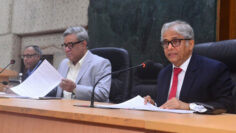275km embankments damaged by erosion
PBC news: Rivers eroded about 275 kilometres of their banks and embankments in the ongoing flood while Water Development Board estimated that they would need Tk 575 crore to repair them.
The loss suffered from river banks and embankments erosion is likely to increase as the country’s major rivers swelled again, especially over the last two days, with an increase in onrush of water from upstream while forecasters are predicting rain to pick up in the north-eastern Indian states over the next four to five days.
Major rivers such as the Jamuna and Padma crossed their flood levels once again in a week or a little more than a week after falling below their danger marks amid forecasts of further flooding at the end of the month.
‘Erosion has remained steady over the last two weeks because of very slow draining of rivers,’ central flood information centre executive engineer Meer Abul Hashem told New Age.
‘But it might turn severe if rivers swell or fall rapidly,’ he said.
The flood information centre said that the worst erosion-affected districts included Kurigram, Gaibandha, Bogura, Sirajganj, Jamalpur, Tangail, Manikganj, Chandpur and Madaripur.
The worst affected areas were mostly by the Brahmaputra and Jamuna rivers though rivers such as the Padma, Teesta and Dharla also caused widespread destruction along their banks, according to the flood information centre.
Erosion so far devoured 168km of unprotected river banks at places in the flood affected 33 districts, said the flood information centre.
The flood information centre calls it a breach when erosion moves inland devouring large areas after sweeping away part of an embankment.
Such breaches occurred at a number of places covering 2.5km along the banks of various rivers.
Embankments covering 8.5km were completely washed away while partial damages occurred along 78km of embankments, said the flood information centre.
The flooding triggered by heavy rains upstream 52 days ago also damaged permanent protection, sluice gates, spar embankments and other infrastructure at various places covering about a total of 20km area.
‘The bad news is that the northern rivers are swelling again and erosion continued there,’ said Hashem.
New Age correspondent in Lalmonirhat reported that the northern rivers devoured 113 houses between Sunday and Monday in Rangpur division.
‘Erosion continued steadily in many areas in the north,’ said WDB north zone chief Jyoti Prashad Ghosh.
Although the WDB centrally do not release any data on houses or other private or public property lost to erosion, its regional offices keep a record of it.
The north zone office of the WDB said that more than 23,000 houses were devoured by rivers in Rangpur division by August 10.
The disaster management and relief ministry said that they were estimating property losses due to erosion which would be released only after the flood was over.
The government erosion forecaster, Centre for Environment and Geographic Information Services, which warns about potential erosion only along the banks of the Brahmaputra, Jamuna and Padma, had predicted loss of 2,385 hectares of land this year.
The WDB North Zone office recorded the loss of 3,745 hectares of land in eight flood-affected districts in Rangpur division alone until August 10.
A Flood Forecasting and Warning Centre bulletin on Monday showed that the Brahmaputra and Jamuna swelled over the 24 hours until 9:00am.
After flowing above their danger marks for more than a month, the rivers fell below their flood levels after one week or a little more than a week ago.
The FFWC bulletin said that the rivers might get steady by Tuesday while the Padma swelled slightly in the last 24 hours until Monday morning.
A total of 53 of the total 101 gauging stations of the FFWC recorded swelling in rivers, with eight of them flowing above their flood levels in eight districts.
The rivers that spilled their banks until Monday were the Jamuna, Dhaleswari, Padma, Karatoa, Gur, Meghna, Betna and Passure.
The rivers around Dhaka such as the Buriganga, Balu, Shitalakhya and Turag also swelled in the 24 hours until Monday morning.
The FFWC said rivers in south-eastern hill basin might swell rapidly over the next two days because of heavy rains inside Bangladesh.
Over 4 lakh people are still affected by flood in Dhaka while over 30,000 were at flood shelters in central Bangladesh according to the latest disaster report of the government released on Sunday.
Over 5.5 million people were affected during the peak of the flood in late July when about 40 per cent of the country went under water.
The health emergency control room said that causes related to the deluge killed 221 people between June 30 and August 17.
Thousands have returned home after staying on embankments or flood shelters for more than a month, though the country’s major rivers began swelling again even before they could start rebuilding their houses.
Amid very heavy rains inside Bangladesh over the last two days, India Meteorological Department predicted heavy to very heavy rains in the north-eastern states over the next five days.
The IMD said that Meghalaya, Nagaland, Manipur, Mizoram and Tripura might get extremely heavy rainfalls on Wednesday and Thursday.
Besides fairly widespread to widespread rainfalls are likely in Arunachal Pradesh, West Bengal and Sikkim and Gangetic West Bengal through Friday, said IMD.
Bangladesh meteorological Department issued heavy rainfall warning for Chattogram and Barishal divisions while predicting heavy falls at many places in other divisions through Tuesday.
Due to strong monsoon the north bay continued to remain rough and the BMD asked all four maritime ports to keep hoisting signal No 3.


















